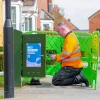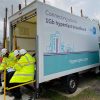Examining the Lack of Gigabit Broadband in Some UK Urban Areas

Most people tend to assume that the problem of slow broadband ISP connectivity is one that predominantly affects rural areas, which is matched by a presumption that commercial operators (Openreach, Virgin Media etc.) will quickly blanket big UK cities and towns with the fastest speeds. But such assumptions are not always correct.
During the many incarnations of Disney’s famous Beauty and the Beast ™, there’s a moment where the lead actress – Bella – strikes up a song and opens with the famous line, “Tale as old as time..“. But it’s usually at this point, while trying not to fall asleep and risk incurring the ire of my daughter, when I’m bizarrely reminded of some old misconceptions around broadband availability in urban areas.
Granted, I need to get out more, but this is an issue you’ll soon be hearing more about, and it’s thus worthy of a little exploration. The last time ISPreview really covered it in any depth was during the latter stages of Openreach’s rollout of Fibre-to-the-Cabinet (FTTC / VDSL2) technology, when a similar problem existed (i.e. dense urban areas were being missed). But the same issue looks set to return for the gigabit era.
Advertisement
The problem is easy enough to see. For example, data from Thinkbroadband (supplied last October) reveals that well over 60,000 premises across London‘s various boroughs are still only able to get online via a slow copper ADSL broadband line, which increases to around 800,000 when you look at premises where the fastest available network is via FTTC (i.e. no gigabit solutions).
A similar story can be found in other cities, such as Manchester, where around 8,700 premises only have access to ADSL, rising to 54,242 premises for those with FTTC as the best option. Some of these patches (or islands) of poor connectivity can even be found in dense central city areas, which are perhaps one of the last places you’d expect to find them (i.e. plenty of potential customers and all packed into an enticingly small geographic area).
Mind the gap
Readers often ask us why locations like this end up being missed out, particularly when all the signs suggest that they should make for ripe pickings amongst aggressively competitive commercial players. We’ve published a simplified list to explain some of the reasons why this occurs, which haven’t changed much since the last time we looked a decade ago.
Obstacles to Dense Urban Gigabit Broadband Builds
➤ No recourse to public funding.
Rural areas that are identified as being the subject of market failure (i.e. too expensive for commercial investment alone to reach) can often benefit from various government voucher schemes and state aid style subsidies, but the same is not true for urban areas.
State aid rules and related value for money exercises often conclude, understandably, that dense urban locations should be upgradable using private funding – without recourse to public investment. Using public money might also be considered anti-competitive in an environment where several operators are likely to be playing.
In the past the UK Government did manage to skate around some of this by launching a Connection Voucher scheme that worked in semi-urban areas (i.e. grants to help homes/businesses get a better connection installed). But that has since been re-focused to become a rural centric scheme, which overlooks the fact that some dense urban areas continue to be left at a digital disadvantage.
➤ A question of ownership.
In some areas it can become very difficult to deploy a new street cabinet or other infrastructure because the ownership of the pavement itself may not be as clear as you would have hoped. But even if you can figure out who owns what and where (public or private land), then there’s also the issue of wayleaves (below).
➤ Wayleave agreements are still challenging (legal property / land access).
At present it can still be tricky for operators to access and upgrade existing infrastructure inside large residential buildings (Multi-Dwelling Units) and on telecoms poles. The Telecommunications Infrastructure (Leasehold Property) Act 2021 was designed to help tackle the problem of unresponsive landlords (here), but it didn’t resolve everything.
Further tweaks are now being made via the new Product Security and Telecommunications Infrastructure Act (PSTI) – here, such as by giving telecoms operators easier access to telegraph poles on private land (public land is not an issue). But it will take time to fully introduce all that. This will also not fully resolve some lingering issues with MDU access (large blocks of flats/apartments – known as Multi-Dwelling Units), which tend to be concentrated in city-centre areas.
For example, operators still face numerous challenges when they try and negotiate access to these properties, including many cases where landlords are totally unresponsive to repeated efforts to start negotiations. In other cases, landlords will be responsive, but operators will struggle to negotiate a mutually acceptable agreement. As above, some of this may be resolved by the new laws, but not all of it and showing a repeated lack of responsiveness by a landlord itself still takes a lot of time.
The MP for Barnsley East, Stephanie Peacock, noted in parliament last year that operators find some of the terms are unnecessarily onerous. For example, they have questioned the need to send a notice by recorded delivery when all previous attempts to make contact have been ignored or rejected, and when many contact addresses for grantors are simply overseas PO boxes. Others have said that they will find it hard to line up permissions, such as those needed from the local authority and those needed for preserving heritage, at the same time.
One catch here is that, by the time access to a nearby MDU has been secured, the build teams have often moved on from the area – it’s naturally fastest and most cost efficient if you can hook-up such buildings when your civil engineering teams are already active just outside the building. Failing to get this right can leave some areas poorly served for a very long time.
In fairness, MDU owners do have concerns too, such as in respect to building insurance, health and safety, damage to the property and so forth. Furthermore, some solutions to these problems might risk handing a commercial benefit to specific operators with a lot of MDUs that need upgrading, such as Openreach.
Suffice to say that issues with securing wayleaves can still be a problem in dense urban areas, which can obstruct the ability to upgrade an existing network or deploy new fibre.
➤ Unexpected build challenges.
Operators trying to build fibre into dense urban areas, such as city centres, can sometimes run into problems due to the existence of old coal cellars / basements, significant congestion of older cable ducts and narrow roads (i.e. no extended curtilage). Such issues can make digging new trenches and toby boxes extremely challenging or even impossible. Resolving this takes a lot of time and money, which may cause some operators to shelve or skip such deployments.
➤ Permits and road closures.
The risk of road closures is also given more significance in city centre areas, where such things can cause significant disruption to travel (e.g. the morning and afternoon rush hour) and thus require much more care and consideration to avoid uproar from residents. Getting the permits to do such work also remains a generally slow and harder process in urban areas.
The Government itself notes that road and street works comprise 70% of the cost of fixed-line network deployment, thus making reforms to the streetworks regulations would be beneficial/support network rollout, particularly if a proper flexi permit scheme was introduced. At present, operators have to obtain a permit for each street where works take place, which creates a significant administrative burden.
Just to give this some more context. Openreach and other operators have helped to pilot alternative flexi-permits where they or network builders can apply to local authorities for a single permit covering a wide geographical area instead of numerous separate street applications. Trials have shown these can significantly reduce the time it takes to roll out networks across a planned area of build.
➤ Exchange Only Lines.
In the past it was often assumed that one of the biggest reasons why some city areas still only have a choice of ADSL is because they were traditionally served by Exchange Only Lines (EoL). In an EOL setup the copper phone line for a home or business is connected directly to a telephone exchange and does not go through a local Street Cabinet. Upgrading these to FTTC requires a complex and costly network rearrangement.
However, it’s not uncommon for the remaining EoLs to exist in areas affected by some of the other aforementioned obstacles, which also helps to explain why FTTP builds may be harder to complete in such locations. Suffice to say that if you’re still living in an urban EoL area, then it could probably be taken as an indication of other challenges preventing deployment of FTTP.
This also means that EoLs themselves are somewhat of a red herring when it comes to FTTP build, since they’re a sympton rather than the cause of a wider problem.
➤ Labour / workforce shortages.
The country is continuing to suffer from a shortage of fibre engineers and, while this does not physically relate to the prevention of build in urban areas, it does certainly have an impact on the pace at which it can be resolved.
The government are working to implement a visa waiver (e.g. adding telecoms engineers to their Short Occupation List) that might make it easier to hire additional skilled engineers from abroad (here), but this probably won’t be implemented until around the autumn of this year.
The good news is that the Government’s new £5bn Project Gigabit programme might finally be starting to recognise the problem. Officially, this project is adopting an “outside-in” approach to build (i.e. rural areas come first) and is intended to help upgrade those rural and semi-rural areas in the final 20% (5-6 million premises) of the UK that aren’t expected to benefit from commercial deployments over the next 3 years.
Advertisement
However, it’s an unavoidable reality that some of the final 20% will also come from urban areas, and the government has already indicated that they’re keen to understand the scale of this issue. As part of that, the Building Digital UK team, which is the executive agency that oversees Project Gigabit, launched a number of Public Reviews (PR) for big urban regions to help identify the limitations of planned commercial deployments (here).
The reviews preliminarily noted that commercial coverage of gigabit-capable broadband would NOT reach 1,704,232 premises in Greater London (Lot 37) over the next 3 years, which shrinks to 569,694 premises for Merseyside and Greater Manchester (Lot 36), then 208,438 premises for Birmingham and the Black Country (Lot 35) and 71,441 premises in the Newcastle and North Tyneside (Lot 38) region.
Suffice to say, there’s a big gap that will need filling in cities too, and we expect more reviews to follow in the future because being able to identify market failure in urban areas is the first step toward a solution. On the other hand, it’s unclear how they plan to resolve such issues, which could raise concerns over the use of a potentially anticompetitive market subsidy.
Mark is a professional technology writer, IT consultant and computer engineer from Dorset (England), he also founded ISPreview in 1999 and enjoys analysing the latest telecoms and broadband developments. Find me on X (Twitter), Mastodon, Facebook, BlueSky, Threads.net and Linkedin.
« LetterOne Challenges Gov Order to Sell UK Full Fibre Network























































I’m in an FTTC area in London that appears to be having it’s first fttp installed on the street. Tw8 9nl and when we spoke to the pole guys they said it was “Hey broadband”
Those with DP poles probably OK as its cheaper and Altnets love it with a bit of OR PIA they get to cover 20 or so customers with minimum investment.
Yeah they were hanging cable off the poles in the street. Seems like such an obvious area to put infrastructure – directly off the A4/M4, I have no idea why no one has targeted this area before.
They have Virgin Media along half the street, but not the other half.
I live in a MDU (36 flats), just a stone throw away (litterally) from the high street of my town that has FTTP. I got an email from Openreach on March 14, stating
“Hi XXXX,
We’re getting in touch to update you on our Ultrafast Full Fibre build. We’ve reviewed our build plans, and currently we can’t deliver Full Fibre to 24, XXXXXX View.
There are lots of reasons for why our plans change – from engineering hazards to access permits. We review our build plans regularly as circumstances change. We hope this is just a temporary setback and that we can bring 24, XXXXXX View back into our Full Fibre build plans in the future.
We’ll keep you updated and let you know immediately if anything changes.”
Needless to say, im not happy. But then, they want all copper phones changed over to the fibre by 2025?? So, my flat/building needs to get done at some point – surely??
“ Needless to say, im not happy. But then, they want all copper phones changed over to the fibre by 2025?? So, my flat/building needs to get done at some point – surely??”
Incorrect, copper services will be around well past 2025, the only thing that is changing is how you receive your voice telephony service, it won’t be by PSTN it’ll be by a digital means which can be served by either ADSL, FTTC, FTTP.
If you’re in a MDU it’s likely that the landlord hasn’t responded to requests by Openreach to upgrade their building. Get all your residents to contact your landlord and provide them with this link: https://www.openreach.com/fibre-broadband/fibre-for-home/are-you-a-landlord
Your building will have FTTP capacity built to the outside ready for the landlord to accept a wayleave for build.
I had one of these emails too. I suspect for me, BT are putting on hold plans to deliver by Dec 2026 because CityFibre just won the Project Gigabit contract for Cambridgeshire and the small town I live in currently has Gigaclear building their network.
I wouldn’t like to assume, but your apartment block could be in a similar situation – somebody else has announce plans to cover your address so BT are changing their plans.
a commercial business making a commercial decision and your surprised
i do wonder about the lack of commerical nous on some of these threads
I don’t think public subsidy is required for dense urban less regulation. Subsidy is only required for remote homesteads where neither FTTP or alternatives are likely to be affordable. The main problem is that landlords/management companies do not regard BB as a significant factor in a shortage of accommodation.
We need to be more inventive. I am not saying all of the following are feasible however more inventive solutions are available (no particular order):
FTTB then Gfast or equivalent (communal power)
FTTB then Flat to Flat WIFI mesh
Strategically sited 5G Mobile Broadband or Wireless equivalent.
A Virgin Media PIA equivalent (where telephone cables directly buried)
Recover gas supplied housing and use existing Gas Pipes for fibre conduit
Others no doubt.
Applies to all providers OR, VM or Altnet.
VM ducts are often blocked when VM need to run a new cable due to bulky coax and economy sized ducts (don’t forget how cheaply the original cable installs were done by predecessor companies), no chance VM would accept a PIA type agreement, nor any sense in trying to force them to.
Using gas pipes, or water, or sewer makes little sense. These pipes are notably deeper than telecoms ducts meaning any customer connections or repairs will involve much higher cost – and any work would interrupt the primary service. Also, pipes operating at pressure have enough losses as it is and can do without additional connections passing through the wall. You could run trunk cables through some (not all) sewers, but generally not a practical option unless you’re talking about man-sized sewers, and for individual property connections not a chance of it being cheaper than just putting in proper ducting.
I would imagine any sane telecoms asset manager would be horrified by the idea of threading telecoms cables through other people’s operational gas or water pipes. So much that can go wrong, so much liability potential, vast cost of training and registrations to work on gas mains, owner inspection costs and delays (and the same with water).
If there’s no Openreach ducts that’s typically because cables were directly buried, which has always been shockingly bad practice, so Openreach need to swallow the cost and put in proper ducts instead of trying to hitch a ride on other service providers assets.
My area, in the Birmingham suburbs, is having Openreach FTTP rolled out, however I’ve been told my cul-de-sac won’t be done because of “direct buried” cables, i.e. the existing copper cables are not in a conduit so they’d have to dig up the street.
Openreach’s official response to my enquiries was that they have “no plans” on how to deal with this situation.
I’m lucky that VM services the road or I’d be totally stuck.
60000 ADSL lines in London are a fraction of a percentage of the total in London. So while an issue it is going to be low on the list of priorities when much higher percentages of lines are a problem in rural and semi rural areas
I had a very similar issues (East London) it was at one point virgin or nothing we only got FTTC in about 2017, but luckily Community Fibre kinda clicked that my entire borough was slightly abandoned by Openreach on FTTP plans
Useless Openreach as always is
Phil: the article and the problem covers all network operators right from Openreach to VM, CityFibre and the other altnets.
You’ve missed the point here spectacularly.
A cracking article, well researched.
My business provides ‘rural’ broadband services via 4g/5g dishes – and it wasn’t until we started exploring this that we realised just exactly how bad urban provision can be (especially here in Sheffield)…
Well written article, building challenges are particularly relevant to me. I’m a Londoner on ADSL2, though Community Fibre signed a wayleave with my landlord in 2021. I live next to a telephone exchange and a LU station, explains why Openreach haven’t bothered & CF is taking so long.
Rural areas deserve priority, as urban areas likely have 5G coverage, making Gigabit internet not as critical.
Well, having gigabit BB is a lot better then relying on 5G but yeah it’s bad my area got CF in 2021 after years of pestering them as we where stuck with virgin or really unreliable VDSL2
I was referring to the network provision within the “dense” and Multi-Dwelling areas.
Getting FTTB should simply be a wayleave issue in FTTP rolled areas.
But why the OR reference? The comment refers to all providers so for instance why can’t Altnets such as FW, Tooli etc use VM duct in OR direct buried areas?. It is not national but its still a monopoly within a given location, especially if VM excludes these dwellings.
If OR provide new duct/box infrastructure it becomes available to PIA so as OR are under no obligation to provide FTTP (now or in future) they are more likely to put difficult areas/roads/premises on the back burner further blighting the homes highlighted within this article.
OR overbuild their DiG areas with microduct and Toby boxes. Can’t PIA that as easily as legacy plant.
PIA doesn’t apply to VM. Add to that their mostly HFC network uses bulky coax, their ducts are persistently blocked even when they themselves want to connect a new customer, so there’s not the spare duct capacity and trying to agree terms for PIA are pointless. Also, If VM aren’t serving an enclave, there’s usually a specific reason they don’t that will apply to any third party, so you’re back to subsidy.
Not defending VM here, just observing that there’s multiple reasons why “just using VM ducts” is not going to offer an widely viable part of a solution.
BDUK currently miss whole urban areas with directly buried cable that will be expensive to do commercially. Openreach certainly miss out many of these currently.
they are expensive to do period by anybody
They’re in scope for Project Gigabit as long as they don’t have Virgin Media cable already.
The entire city of Oxford and all surrounding housing estates basically have no fibre (FTTP) at all, other than one small new build estate. Just as soon as you move outside the council boundary there’s alt-net fibre almost everywhere.
Absolutely ridiculous trying to work in what is supposed to be a high tech area, when you only have 5-10 Mbps max upload available at home.
If only the council was more interested in working with providers rather than trying to fine people from driving their cars
Openreach claim FTTP will be available in central and south Oxford and surrounding areas within 12 months. Virgin Media is available in much of Oxford too.
https://www.netomnia.com/news/oxford-broadband-boost/
Oxford is a nightmare for many reasons though Virgin Media have a fair amount of gigabit presence.
A few obstacles. Not aware of the council being especially problematic. Netomnia are happily doing their thing, having started in East Oxford. Have a look at Think Broadband’s maps.
Council are presumably busy keeping new housing away from the city to ensure it keeps its status as the least affordable relative to incomes in the country.
“landlords will be responsive, but operators will struggle to negotiate a mutually acceptable agreement.”
Translation: Landlords are rent seeking leeches and want to be paid for the improvement to their property
“I do not understand the difference between a housing association and someone renting their own property but let me type my communist line out anyway”
One potential solution for Market 2 areas is for a loan to be provided to get FTTP installed. The loan being repaid when take up reached a certain level
I suspect though the main constraint at present is resource
Having multiple companies install in an area is also wasteful of resource
In my view it is pretty certain that most of these alt nets will consolidate to no more than a couple of companies. You only have to look at what happened with cable TV
Take a look at Exmouth, Devon, there’s a large not-spot of FTTP in the middle of a housing estate, yep, that’s where I am! VM and Jurassic Fibre are doing build work but my street is cables buried in dirt aka the “direct bury” / “greenfield” method as I’ve heard it called. No spades in the ground to date but I’ve seen Jurassic dig and duct a fair few parts of Exmouth, so there’s hope yet!